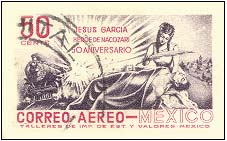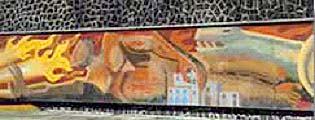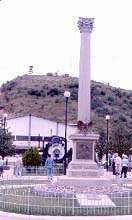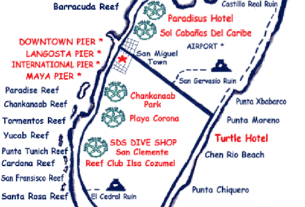
There are all kinds of heroes, from the international arena to the local, and in one’s own neighborhood or family. Most heroes are defined by courageous or exemplary behavior while facing extreme adversity or challenge. Each profession has heroes, too those who make significant contribution to advancing its purpose or goals.
This is the story of a man, Jesús García, suddenly faced with a life and death dilemma, who valiantly tried to avert a tragedy of monumental proportions. He only partly succeeded, but he had made the choice to try, knowing the huge personal risk he was taking. He acted heroically, and he has been recognized as a hero, in Mexico and among railroad buffs, and to a limited extent, in the United States.
Nacozari lays in northeastern Sonora, near the U. S. border at Arizona. A large body of copper ore near the old town of Nacozari was named the Pilares de Nacozari. In 1895, the American company Phelps Dodge purchased the property and through a subsidiary, Moctezuma Copper Company, made large investments to increase production. The mine at Pilares was expanded and a new town and processing center were built nearby. Material and equipment for the huge project were brought in from Arizona on mule drawn wagons. Well over half of Mexico’s copper production came from Sonora. At Pilares de Nacozari, the amount of ore mined increased 86,660 tons in 1901, to 348,630 tons in 1910, and to 542,363 tons in 1912.
Ore moved from the concentrator at Nacozari on a six mile narrow gauge railway owned and operated by Moctezuma Copper Company. The narrow gauge line was steep as the mine lay some two thousand feet higher in the mountains northeast of the company town of Nacozari. The main rails from Arizona also came through town and ended at the concentrator. Large amounts of dynamite were imported from Arizona for blasting the ore out of the hard rock mine, and the most convenient location for the dynamite storage was near the concentrator where the rail lines were close together. Also nearby were mammoth shops, warehouses, a power plant with gas storage tanks, and just across the river, the town of Nacozari with about 5.000 residents.
 Jesus was a hardworking man and at the age of 26 he was in line to be chief engineer for the company railroad. He was born November 13, 1883 in Hermosillo, and had arrived with his mother and seven older siblings in Nacozari in 1898. Handsome, energetic, courteous Jesús García was well liked by all. On November 7, 1907, he went to work as usual after a night; it is said, full of music and romance. However, on that day, his last, he proved to be a hero.
Jesus was a hardworking man and at the age of 26 he was in line to be chief engineer for the company railroad. He was born November 13, 1883 in Hermosillo, and had arrived with his mother and seven older siblings in Nacozari in 1898. Handsome, energetic, courteous Jesús García was well liked by all. On November 7, 1907, he went to work as usual after a night; it is said, full of music and romance. However, on that day, his last, he proved to be a hero.
Major happenings sometime result from an unfavorable combination of situations. Jesús noticed that the smokestack was not smothering all the ashes from his engine. He told the fireman he would report it to maintenance at the end of the shift. In addition, the conductor was sick and did not come to work that day. In the early afternoon, Jesus Garcia was instructed to take a five-car train containing two railcars loaded with dynamite to the mine. If the conductor, responsible for proper operations and safety of the train had been there, perhaps the cars laden with dynamite would have been placed at the rear rather than at the front of the train. Moreover, when the loading was finished and Jesús García returned from lunch, the fire in the boiler had burned low and the engine did not have full steam pressure for the arduous climb to the mine. Maybe that distracted him from noticing that the dynamite was right behind the engine.
 Just after two, the train pulled away, building full power for the uphill run. Smoke was blown back over the train and live ashes from the defective stack must have landed on the first two cars because soon smoke was seen coming from the boxes of dynamite. At first, he slowed the train while a brakeman tried to pry loose a smoldering box and toss if off. However, when it was raised, flames shot out and quickly spread. Jesus ordered the crew to jump and gave full throttle to Engine No 2, trying to reach open ground beyond the town and the upper rail yard, named El Seis. Two tons of dynamite exploding so close to town near the large dynamite magazine and gas storage tanks, would have been a disaster for Nacozari. If he abandoned the train, it would have rolled down the steep grade and back into town.
Just after two, the train pulled away, building full power for the uphill run. Smoke was blown back over the train and live ashes from the defective stack must have landed on the first two cars because soon smoke was seen coming from the boxes of dynamite. At first, he slowed the train while a brakeman tried to pry loose a smoldering box and toss if off. However, when it was raised, flames shot out and quickly spread. Jesus ordered the crew to jump and gave full throttle to Engine No 2, trying to reach open ground beyond the town and the upper rail yard, named El Seis. Two tons of dynamite exploding so close to town near the large dynamite magazine and gas storage tanks, would have been a disaster for Nacozari. If he abandoned the train, it would have rolled down the steep grade and back into town.
The train was rushing away from town, passing through a curved, shallow cut in a hillside, not quite to the upper rail yard, when, at 2:20 PM, it blew! He, along with several people living nearby, was killed instantly. Many were injured. Jesus Garcia spared the town of Nacozari, thanks to his act of bravery.
Newspapers worldwide reported the incident and with company executives and politicians, declared Jesús Garcia a hero. Many cities and towns in northern Mexico erected monuments in his honor, and of course, there is a large monument to him in the main plaza in Nacozari. In 1917, his remains were buried at the base of the monument. When the Pilares mine closed and the railway shut down, the last locomotive, Engine 501, was brought to town and Jesús Garcia’s name inscribed on it. The ballad honoring him has the title Máquina 501, perhaps for this reason. Since 1944, November 7 is known in Mexico as the Day of the Railroader. On November 7, 1957, a stamp (Scott No. C242) was issued to commemorate the 50th anniversary of Jesús Garcia’s heroic deed.
Originally published in Mexicana, the official journal of Mexico Elmhurst Philatelic Society International and has been reproduced by permission. Content has been edited and additional illustrations added.
See also:
- Did You Know? The Hero of Nacozari by Tony Burton



